(!)Due to Microsoft's end of support for Internet Explorer 11 on 15/06/2022, this site does not support the recommended environment.
Instead, please kindly use other browsers like Google Chrome, Microsoft Edge or Mozilla Firefox.
50,000 Stock items for Same Day Ship Out.
All Categories
Categories
- Automation Components
A wide variety of standard and configurable components for factory automation engineers in industries such as automotive, semiconductor, packaging, medical and many more.
- Linear Motion
- Rotary Motion
- Connecting Parts
- Rotary Power Transmission
- Motors
- Conveyors & Material Handling
- Locating, Positioning, Jigs & Fixtures
- Inspection
- Sensors, Switches
- Pneumatics, Hydraulics
- Vacuum Components
- Hydraulic Equipment
- Discharging / Painting Devices
- Pipe, Tubes, Hoses & Fittings
- Modules, Units
- Heaters, Temperature Control
- Framing & Support
- Casters, Leveling Mounts, Posts
- Doors, Cabinet Hardware
- Springs, Shock Absorbers
- Adjusting, Fastening, Magnets
- Antivibration, Soundproofing Materials, Safety Products
- Fasteners
A good selection of accessories such as screws, bolts, washers and nuts that you may need for your daily engineering usage.
- Materials
Browse industrial materials ranging from heat insulating plates, sponges, to metal and plastic materials in different sizes to meet your various applications.
- Wiring Components
A wide variety of wiring parts for connecting and protecting control and PC parts including Connectors, Cables, Electric Wires, Crimping Terminals and more.
- LAN Cables / Industrial Network Cables
- Cables by Application
- Cables with Connectors
- RS232 / Personal Computers / AV Cables
- Wires/Cables
- Connectors (General Purpose)
- Crimp Terminals
- Zip Ties
- Cable Glands
- Cable Bushings/Clips/Stickers
- Screws/Spacers
- Cable Accessories
- Tubes
- Protection Tubes
- Ducts/Wiremolds
- General Purpose Tools
- Dedicated Tools
- Soldering Supplies
- Electrical & Controls
A wide variety of controls and PC parts for electrical engineers including Controls, Powers, PC parts and more.
- Cutting Tools
A wide variety of cutting tools for many uses and work materials including End Mills, Drills, Cutters, Reamers, Turning Tools and more.
- Carbide End Mills
- HSS End Mills
- Milling Cutter Inserts/Holders
- Customized Straight Blade End Mills
- Dedicated Cutters
- Turning Tools
- Drill Bits
- Screw-Hole-Related Tools
- Reamers
- Chamfering / Centering Tools
- Fixtures Related to Cutting Tools
- Step Drills
- Hole Saws
- Clean Key Cutters
- Core Drills (Tip Tools)
- Magnetic Drilling Machine Cutters
- Drill Bits for Electric Drilling Machines
- Woodworking Drill Cutters
- Drills for Concrete
- Processing Tools
A wide variety of tools and supplies used in processing including Machine Tools, Measurement Tools, Grinding and Polishing Supplies and more.
- Material Handling & Storage
A wide variety of goods used in shipment, material handling and warehouse including Tape supplies, Stretch film, Truck, Shelf, Crane and more.
- Tape Supplies
- Cushioning Materials
- Stretch Films
- Cardboard
- Plastic Bags
- PP Bands
- Magic Tapes / Tying Belts
- Rubber Bands
- Strings/Ropes
- Cable Ties
- Tags
- Labelers
- Unpacking Cutters
- Packing Support Equipment
- Cloth Sheets for Packing
- Conveyance/Dolly Carts
- Tool Wagons
- Tool Cabinets / Container Racks
- Lifters / Hand Pallets
- Container Pallets
- Storage Supplies
- Shelves/Racks
- Work Benches
- Suspended Clamps/Suspended Belts
- Jack Winches
- Chain Block Cranes
- Bottles/Containers
- Bicycle Storage Area
- Safety & General Supplies
A large variety of goods for every kind of factories and offices including Protection items, Cleaning supplies, sanitations, office supplies and more.
- Lab & Clean Room Supplies
A large variety of items used in R&D and Clean Room including research Equipment, Laboratory Essentials, Analysis Supplies, Clean Environment-Related Equipment and more.
- Press Die Components
Choose from thousands of standard stamping die components including Punch & Die, Gas Springs, Guide Components, Coil Springs and many more.
- Plastic Mold Components
Browse our wide variety of mold components including Ejector Pins, Sleeves, Leader Components, Sprue Bushings and many more.
- Ejector Pins
- Sleeves, Center Pins
- Core Pins
- Sprue bushings, Gates, and other components
- Date Mark Inserts, Recycle Mark Inserts, Pins with Gas Vent
- Undercut, Plates
- Leader Components, Components for Ejector Space
- Mold Opening Controllers
- Cooling or Heating Components
- Accessories, Others
- Components of Large Mold, Die Casting
- Injection Molding Components
Browse our injection molding components including Heating Items, Couplers, Hoses and more.
- Injection Molding Machine Products
- Accessories of Equipment
- Auxiliary Equipment
- Air Nippers
- Air Cylinders
- Air Chuck for Runner
- Chuck Board Components
- Frames
- Suction Components
- Parallel Air Chuck
- Special Air Chuck
- Chemical for Injection Molding
- Mold Maintenance
- Heating Items
- Heat Insulation Sheets
- Couplers, Plugs, One-touch Joints
- Tubes, Hoses, Peripheral Components
Search by Application
Brands
- Notice of End of Sales for Economy Series Pneumatic Equipment Category. More information.
- Please be informed that our operating hours during the upcoming National Day Holiday 2024 will be from 9:00~15:00. Additionally, please note that our supplier will be closed from 13~15th August 2024 for the Obon holiday. Click here for details.
Drilling methods and types
Opening cylindrical holes and tapped holes
Drilling is a means of opening cylindrical holes using cutting tools. These holes can be both
shallow and deep. There are various post-drilling processes including broaching, reaming, and
counter boring, while there are also various finishing processes such as skiving and roller
burnishing.
In these processes, the drill rotates and moves in a linear motion.
The high-speed steel (HSS) twist drill that was developed more than 50 years ago is still used
today. Development of new HSS and carbide drills has also advanced, and there has been rapid
progress in the development of replaceable blade-type drills for high productivity. The majority
of workpieces have 1 or multiple holes, and many are processed using CNC lathes or in machining
centers. Dedicated drilling machines are on the decline.
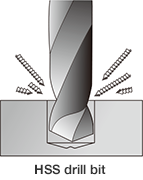
Cutting conditions
The cutting conditions required for drilling are the same as those for turning and milling.
| Spindle speed (n) | Drill rotational speed (spindle rotational speed) (rpm) |
|---|---|
| Cutting speed (Vc) |
Blade surface cutting speed (m/min.)  D is the drill diameter; n is the spindle speed (drill rotational speed) |
| Feed rate (Vf) |
The feed (fn) per rotation is also important. The combination of cutting speed and feed per rotation changes the tool’s lifespan and cutting chip processing performance. Feed per minute (Vf) is the speed at which the drill enters and opens a hole in the workpiece. Vf = fn × n (mm/min.) |
|
Feed × Rotational speed = Cutting speed *Example using an HSS twist drill |
|---|
|
The cutting speed (rotational speed) is 20 m/min.
(1) The drill will move 31.4 mm at 1 rotation per
second.
ø10 mm × 3.14 × 1 rotation = 31.4 mm/sec. In per minute speed, this is 31.4 × 60 = 1,884 mm/min. In meters, this is 1,884 ÷ 1,000 = 1.884 m/min. 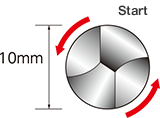
(2) At 10 rotations per second
ø10 mm × 3.14 × 10 rotations = 314 mm/sec. In per minute speed, this is 314 × 60 = 18,840 mm/sec. In meters, this is 18,840 ÷ 1,000 = 18.84 m/min. 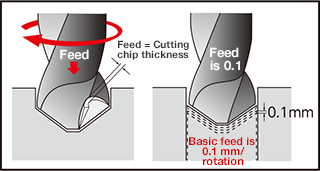
At 600 rotations per minute, 0.1 × 600 = 60 mm/min. |
What is thinning
Thinning is the process of forming the cutting edge of the web of the drill.
A small part of the web on the chisel edge is removed, and the cutting edge is formed as a
negative rake angle.
Thinning mainly improves the performance of the chamfer of the drill and reduces cutting force,
and so can help to improve drilling efficiency.
| Shape |
X style 
|
XR style 
|
S style 
|
N style 
|
|---|---|---|---|---|
| Features | This style greatly reduces thrust load and improves the performance of the chamfer. It is effective when the web is comparatively large. | Although the performance of the chamfer is slightly inferior to that of the X style, the cutting edge is incredibly strong and it is compatible with a wide range of work material. This style has a long lifespan. | This style allows for easy grinding and is commonly used. | It is effective when the web is comparatively large. |
| Main application | General drilling, deep hole drilling | General drilling, stainless steel drilling | General drilling for steel, cast iron, and non-ferrous metals | Deep hole drilling |
Drilling information
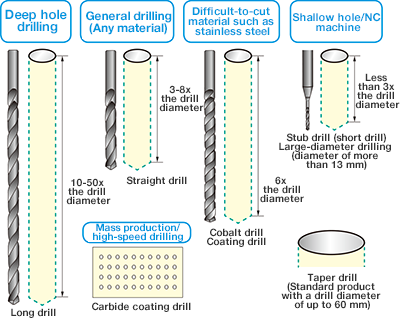
General drills
■ Straight drills

■ Taper drills
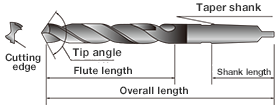
| Blade shape |

|

|

|
|---|---|---|---|
| Application | General use | Cast iron and aluminum | Manganese steel and high hardness materials |
3 drilling types
|
Solid drilling (pure drilling) |
The most common type of shallow hole drilling is pure drilling (solid drilling). 
|
|---|---|
|
Trepanning *Using a trepanning drill |
Trepanning is mainly used to drill large-diameter holes. 
|
|
Counter boring *A drilling method used to make an existing hole bigger |
Although sometimes throw-away drills are used, normally the accuracy is not enough. As a pilot hole makes the drill cutting edge shape asymmetric, the load on the cutting edge becomes uneven, and the drill makes the recess diameter shorter. As such, the drill is impacted by the machining allowance of the pilot hole, and drilling accuracy worsens. 
|
Oil amount and oil pressure
In drilling, the amount of cutting oil and the oil pressure is key. Cutting chips are constantly generated in the drilling process, and so it is essential that these chips are quickly discharged. When a drill is drilling deep into a workpiece, cutting oil spreads across the surface of the drill tip to promote smooth chip generation. These chips must be discharged via the channel through which the main drill body passes. The amount of cutting oil is measured at the exit point of the cutting edge.
For example:
20 liters per minute are required for drill diameter of 20 mm.
Indexable drill (throw-away drill)
Indexable drills come in 2 types: Head replacement type drills (in which the shape of the insert is the shape of the drill tip) and tip replacement drills.
Reference: Coco Mite Vol. 2


